Related Research Articles

The Sinhalese people, also known as the Sinhalese are an Indo-Aryan ethno-linguistic group native to the island of Sri Lanka. Historically, they were also known as the Helas or the Lion People. They are the largest ethnic group in Sri Lanka, constituting about 75% of the Sri Lankan population and number more than 15.2 million.

The Tamil people, also known as Tamilar, Tamilians, or simply Tamils, are a Dravidian ethnolinguistic group who natively speak the Tamil language and trace their ancestry mainly to India's southern state of Tamil Nadu, the union territory of Puducherry, and to Sri Lanka. The Tamil language is one of the world's longest-surviving classical languages, with over 2000 years of Tamil literature, including the Sangam poems, which were composed between 300 BCE and 300 CE. People who speak Tamil as their mother tongue and are born in Tamil clans are considered Tamils.

The culture of Sri Lanka mixes modern elements with traditional aspects and is known for its regional diversity. Sri Lankan culture has long been influenced by the heritage of Theravada Buddhism passed on from India, and the religion's legacy is particularly strong in Sri Lanka's southern and central regions. South Indian cultural influences are especially pronounced in the northernmost reaches of the country. The history of colonial occupation has also left a mark on Sri Lanka's identity, with Portuguese, Dutch, and British elements having intermingled with various traditional facets of Sri Lankan culture. Additionally, Indonesian culture has also influenced certain aspects of Sri Lankan culture. Culturally, Sri Lanka possesses strong links to both India and Southeast Asia. For over 2,500 years, India and Sri Lanka have nurtured a legacy of historical, cultural, religious, spiritual, and linguistic connections.
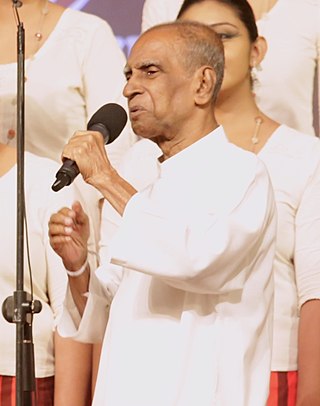
Sri Lankabhimanya Wannakuwattawaduge Don Albert Perera, better known by his adopted name Amaradeva, was a prominent Sri Lankan Sinhalese vocalist, violinist and composer. Primarily using traditional instruments like sitars, tablas and harmoniums, he incorporated Sinhala folk music with Indian ragas in his work. Many consider his contribution to the development of Sinhala music as unmatched; hence, he is occasionally cited as the "Maestro of Sri Lankan Music".

Buddhist art is visual art produced in the context of Buddhism. It includes depictions of Gautama Buddha and other Buddhas and bodhisattvas, notable Buddhist figures both historical and mythical, narrative scenes from their lives, mandalas, and physical objects associated with Buddhist practice, such as vajras, bells, stupas and Buddhist temple architecture. Buddhist art originated in the north of the Indian subcontinent, in modern India, Pakistan and Afghanistan, with the earliest survivals dating from a few centuries after the historical life of Siddhartha Gautama from the 6th to 5th century BCE.

The Toluvila statue is a seated image of the Buddha discovered in 1900 in Anuradhapura, Sri Lanka, that dates back to the 4th or 5th century. Carved out of granite, it is one of the best-preserved sculptures from Sri Lanka and is similar to the Samadhi statue of Anuradhapura. Some features of the statue indicate that it may have been influenced by the Mathura School. The statue is now kept at the National Museum of Colombo.
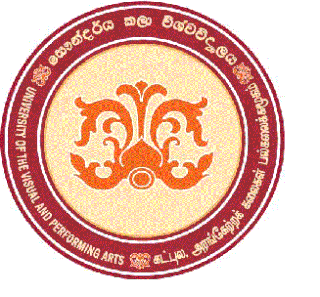
University of the Visual and Performing Arts (UVPA) is a public university located primarily in Colombo, Sri Lanka, specialising in art, design, fashion and the performing arts. It was formerly known as the Government College of Fine Arts, Heywood Institute of Art and the Institute of Aesthetic Studies of the University of Ceylon. It has no known date of foundation, but there is evidence of teaching as far back as 1893. It is the only university in Sri Lanka to exclusively offer special degree programs in visual and performing arts.
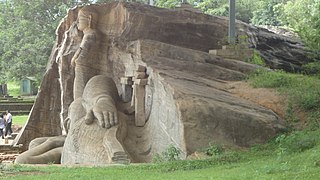
The Gal Vihara, and known originally as the Uttararama, is a rock temple of the Buddha situated in the ancient city Polonnaruwa, the capital of the ancient Kingdom of Polonnaruwa, now present-day Polonnaruwa, in North Central Province, Sri Lanka. It was fashioned in the 12th century by King Parakramabahu I. The central feature of the temple is four rock relief statues of the Buddha, which have been carved into the face of a large granite gneiss rock. The images consist of a large seated figure, another smaller seated figure inside an artificial cavern, a standing figure, and a reclining figure. These are considered to be some of the best examples of ancient Sinhalese sculpting and carving arts, and have made the Gal Vihara the most visited monument at Polonnaruwa.

Chalermchai Kositpipat is a Thai visual artist. Primarily a painter known for his use of Buddhist imagery, Chalermchai's works have been exhibited worldwide.

Malaka Dewapriya (Sinhala: මාලක දේවප්රිය, IPA:[maːləkədeːʋaprijə] is a Sri Lankan film maker, visual artist, Sinhala Radio Play writer, short film and video director.
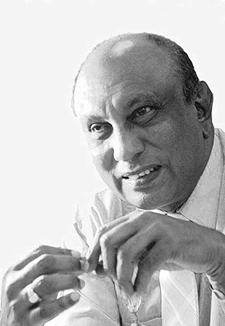
Deshabandu Tissa Ananda Abeysekara was a Sri Lankan filmmaker, actor, writer, director, screen playwright and political activist. He is better known as a script writer for the cinema as well as a film director. In 1996, his book Bringing Tony Home won the prestigious Gratiaen Prize for the new creative writing in English. He was the chief coordinator of FOSWAL in Sri Lanka and honoured awardee of SAARC Literary Award.
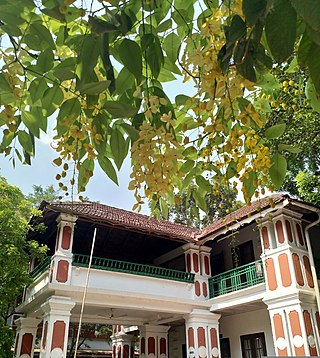
Government College of Fine Arts, Thrissur is located in the heart of the city of Thrissur in Kerala state of India. More than hundred years of existence has given a unique character to this institution in the history of art institutions in India. As a graduate level art college, this institution initiate young minds to work with the world of Art and Design and make a life in their own terms. As a Technical Commercial Industrial School, it was in 1910 that this institution started functioning. At that time, art education was basically an industrial training in order to produce skilled craftsmen and related vocational labors. During the second world war, the institution was renamed as ‘Government Trade School’. From 1943 to 1975, it was known as Government Occupational Institute. The fundamental shift from a vocational labor towards a more aesthetic ‘Fine Arts’ orientation occurred when it was upgraded as Govt.Institute of Fine Arts, in the year 1975. This was also about a raise and shift in the status of ‘artist’ in the modern sense of the term. In 1988 the title called National Diploma offered by this institute for its five year courses, gave training in Painting, Sculpture and Applied Art. In 2000, the status of this institute was raised as it got affiliated with the University of Calicut and started offering four year Bachelor of Fine Arts degree in three specialisations: Painting, Sculpture and Applied Arts. In the year 2019, a new course in Art History and Visual Studies has also started.

Vishvanath Buddhika Keerthisena, also known as Boodee Keerthisena, is a Sri Lankan filmmaker. He began his career drawing comics before moving into painting, dress design, and visual arts. He moved into music in the late 1980s, and performed in a band called "Boo-Dee and the Woo-Zees" (1986–1992) as the lead singer.

Angampora is a Sinhalese martial art that combines combat techniques, self-defense, sport, exercise, and meditation. A key component of angampora is the namesake angam, which incorporates hand-to-hand fighting, and illangam, involving the use of indigenous weapons such as the ethunu kaduwa, staves, knives and swords. Another component known as maya angam, which uses spells and incantations for combat, is also said to have existed. Angampora's distinct feature lies in the use of pressure point attacks to inflict pain or permanently paralyze the opponent. Fighters usually make use of both striking and grappling techniques, and fight until the opponent is caught in a submission lock that they cannot escape. Usage of weapons is discretionary. Perimeters of fighting are defined in advance, and in some of the cases is a pit.
Prasanna Jayakody is a Sri Lankan film director and screenwriter, internationally recognized for his cinematic accomplishments in contemporary Sri Lankan cinema. His movies primarily explore the human state of mind. They are fusions of human emotions, senses and thoughts set against the fractured socio-economic, cultural and religious environments of Sri Lanka. In the global context, Jayakody’s cinema represents the psycho-biological realities of mankind and arbitrariness of human cognition juxtaposed against the larger concept of civilization. Jayakody’s eccentric cinematic world, in the absence of a flowing story, capitalizes on subtle but detailed images and intense characters.
Saumya Liyanage is an actor in Sri Lankan cinema, stage drama and television. He is a senior lecturer and currently the Dean, Faculty of Graduate Studies in University of the Visual and Performing Arts by profession. Highly versatile actor mainly involved in dramatic roles, Saumya is the son of veteran dramatist Hemasiri Liyanage and brother of musician Indrachapa Liyanage.
Krishanadasa Narayana Bandaranayaka Brahmachari Mudiyanselage Parakrama Bandara Niriella, popularly as Parakrama Niriella, is a Sri Lankan director in Sri Lankan cinema, theater and television. One of the pioneer dramatists in Sri Lankan drama, Niriella is the founder of the "Janakaraliya" Drama troupe. He is also a stage playwright, a film script writer.
Sirimathi Mary Fernando [Sinhala]), popularly as Sirimathi Rasadari, was an actress in Sri Lankan cinema, as well as a renowned Kathak dancer. Considered as the first in Sri Lanka to mastered the art of dancing, acting, singing and writing at the same time, she is the pioneer to establish United Ceylon Fan Club in 1957.
Bulathsinhalage Janani Chandima Cooray is a Sri Lankan contemporary performance artist, art educator and painter. She is regarded as one of the leading performance artists in Sri Lanka. She has held exhibitions around the world, including Bangalore, Colombo and London.
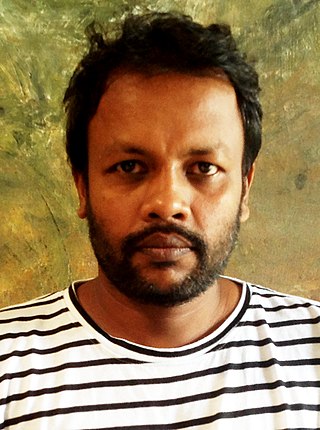
Chamila Gamage is a Sri Lankan Contemporary Artist and Sculptor. His innate talent can be seen through number of different mediums including painting and drawing, sculpting and set designing. Chamila's styles are abstract art, modern art, expressionism art.
References
- ↑ "Sri Lankan art history: Introduction" . Retrieved 26 March 2015.